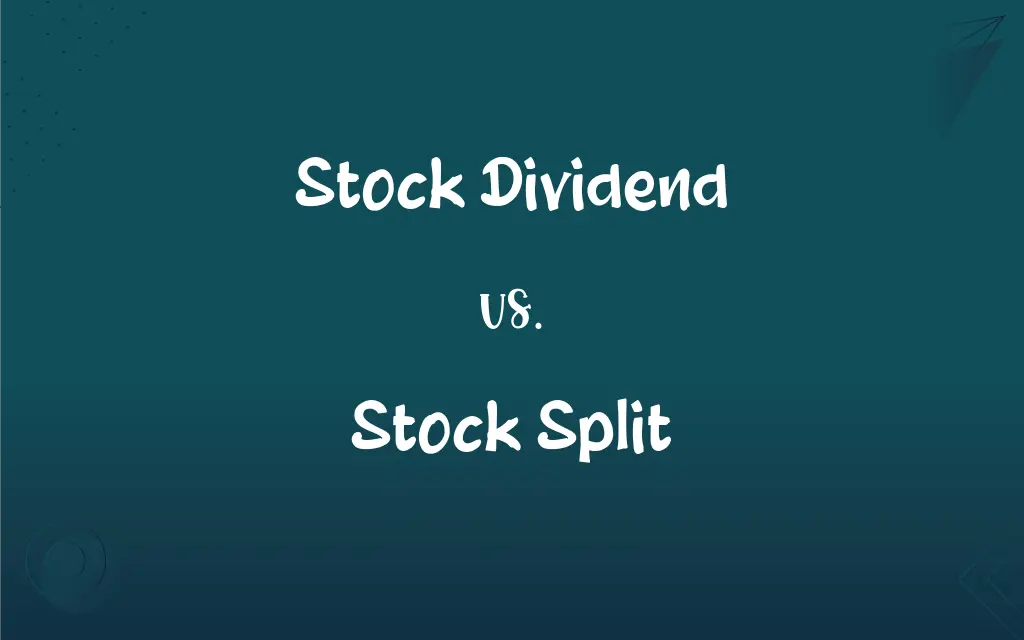Stock Dividend vs. Stock Split: What's the Difference?
By Janet White || Published on November 21, 2023
A stock dividend is a payment made in additional shares, while a stock split increases the number of shares by dividing existing shares.

Key Differences
A stock dividend is a dividend payment made to shareholders in the form of additional shares, reflecting a company's desire to reward shareholders without reducing cash reserves. A stock split, on the other hand, is a corporate action that increases the number of shares outstanding by splitting existing shares.
In a stock dividend, shareholders receive additional shares, increasing their shareholding without investing more money. In a stock split, the shareholder's total value remains the same, but the number of shares they own increases, making the shares more affordable to small investors.
Stock dividends do not significantly change the value of the company but dilute the share price slightly. Stock splits result in a reduction of the stock price (for example, in a 2-for-1 split, the price is halved) but do not change the market capitalization of the company.
Companies issue stock dividends typically to conserve cash while still providing a dividend. Stock splits are usually done to lower the share price and make the stock more accessible to a broader range of investors.
Stock dividends are less frequent and can affect the retained earnings on the balance sheet. Stock splits are purely cosmetic and do not impact the financial statements of a company.
ADVERTISEMENT
Comparison Chart
Nature
Payment in additional shares
Increase in share count by dividing existing shares
Impact on Shareholders
Increases number of shares owned
Increases number of shares, reducing price per share
Effect on Share Value
Slight dilution of share price
Reduces share price, keeping total value constant
Purpose
To reward shareholders without using cash
To make stock more accessible and liquid
Financial Statement Impact
Affects retained earnings
No direct financial statement impact
ADVERTISEMENT
Stock Dividend and Stock Split Definitions
Stock Dividend
A dividend payment made in the form of additional shares.
The company issued a 5% stock dividend, increasing each shareholder's number of shares.
Stock Split
A corporate action that divides existing shares into multiple new shares.
The company's 2-for-1 stock split doubled the number of shares each shareholder owned.
Stock Dividend
A method of rewarding shareholders by increasing their shareholding.
Shareholders were pleased with the stock dividend, as it expanded their investment.
Stock Split
A division of shares that leaves the total value of holdings unchanged.
Although the stock split halved the price per share, the total value of my investment remained the same.
Stock Dividend
An issuance of new shares proportional to current ownership.
For every 100 shares owned, the stock dividend provided 10 additional shares.
Stock Split
A move to increase liquidity and trading volume of a stock.
Post stock split, there was a notable increase in the stock's trading volume.
Stock Dividend
Additional shares given to shareholders instead of cash dividends.
To conserve cash, the board declared a stock dividend this year.
Stock Split
An increase in the number of shares that reduces the price per share.
After the stock split, the share price was more attractive to small investors.
Stock Dividend
A reinvestment of earnings into shareholders' equity in the form of shares.
The stock dividend reflected the company's strong earnings growth.
Stock Split
A strategy to make a company's shares more affordable.
The stock split made it easier for more investors to buy shares in the company.
FAQs
What is a stock dividend?
It's a dividend paid in the form of additional shares.
Do stock dividends dilute share value?
Yes, but only slightly.
What impact does a stock dividend have on a company’s cash flow?
It conserves cash by paying dividends in shares instead of cash.
Why do companies perform stock splits?
To make the stock price more accessible and increase liquidity.
How often do companies issue stock dividends?
Less frequently, as it depends on the company’s dividend policy and financial health.
Can a stock split affect a company's market cap?
No, it doesn't change the company's market capitalization.
How does a stock split differ from a stock dividend?
A stock split increases the number of shares by dividing existing ones, while a stock dividend is a distribution of additional shares.
Is a stock split beneficial for small investors?
Yes, it makes shares more affordable.
Can I sell the shares received from a stock dividend?
Yes, these shares can be sold like any other shares.
Does a stock split change my percentage ownership in a company?
No, your percentage ownership remains the same.
How is a stock dividend different from a cash dividend?
It's paid in shares instead of cash.
Can all companies issue stock dividends?
Only if they have sufficient retained earnings and authorized shares.
Do stock splits affect dividend payouts?
The per-share dividend may be adjusted to reflect the increased share count.
What is a typical stock split ratio?
Common ratios include 2-for-1 or 3-for-1.
Does a stock split imply that a company is performing well?
Not necessarily, but it often reflects a positive market perception.
What happens to my dividends after a stock split?
They may be adjusted according to the new share count.
Why might a company choose a stock dividend over a cash dividend?
To retain cash for reinvestment while still rewarding shareholders.
Are stock dividends taxable?
Yes, they can be subject to taxation.
Is a stock split a sign of future growth?
It's not a direct indicator of future growth, but it shows management's confidence in the company.
Who decides to issue a stock dividend?
The company's board of directors.
About Author
Written by
Janet WhiteJanet White has been an esteemed writer and blogger for Difference Wiki. Holding a Master's degree in Science and Medical Journalism from the prestigious Boston University, she has consistently demonstrated her expertise and passion for her field. When she's not immersed in her work, Janet relishes her time exercising, delving into a good book, and cherishing moments with friends and family.






































































